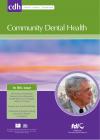Community Dental Health

- Cover Date:
- December 2009
- Print ISSN:
- 0265 539X
- Vol:
- 26
- Issue:
- 4
Rural Mexican immigrant parents’ interpretation of children’s dental symptoms and decisions to seek treatment
Objective: Mexican-origin children have higher rates of decay and lower dental utilization rates than children from all other racial/ethnic groups. Different cultural groups’ interpretations of dental symptoms illuminate their different decision-making process about seeking care. Through ethnography in a small rural U.S. city, we examined low-income Mexican immigrant caregivers’ interpretations of their children’s dental symptoms and evaluations of the need for treatment. Basic Research Design: We conducted 49 in-depth interviews with 26 Mexican immigrant caregivers about their perceptions of their children’s dental symptoms, and observations of five such caregivers’ help-seeking episodes and 30 other caregivers’ presentation of their children’s symptoms at dental clinics. All interviews and fieldnotes were analyzed qualitatively through a series of readings and codings. Results: A conceptual model of caregivers’ decision-making processes was developed. Most caregivers deduced the health of teeth from visible appearance, and thus children’s complaints of pain alone were often ineffective in triggering a dental visit. Caregivers often delayed treatment because they viewed their children’s oral disease as mere “stains†requiring cleaning rather than as bacterial infections requiring restorative treatment. Parents appeared to confuse carious “stains†with fluorosis stains common in rural Mexico. Conclusions: Even when Mexican immigrant caregivers recognize a dental problem, they often misinterpret it as a “stain.†Caregivers’ interpretations of decay were shaped by their lack of experience with children’s decay in rural Mexico. Oral health education programs should help rural immigrant caregivers distinguish between “stains†and “cavities,†and understand the heightened oral hygiene requirements of the cariogenic diet in industrialized countries.
Key words: Dental help-seeking, Early Childhood Caries, ethnography, immigrants, Latino/Hispanic children, low income, oral health education, parental health beliefs and behaviors, rural
- Article Price
- £15.00
- Institution Article Price
- £
- Page Start
- 216
- Page End
- 221
- Authors
- S. Horton, J.C. Barker
Articles from this issue
- Title
- Pg. Start
- Pg. End
- Evaluation of the direct and diffusion methods for the determination of fluoride content in table salt
- 204
- 210
- Rural Mexican immigrant parents’ interpretation of children’s dental symptoms and decisions to seek treatment
- 216
- 221
- Assessment of HIV/AIDS awareness among 500 patients referred to the Ankara University Faculty of Dentistry
- 222
- 226
- Professional charges not reimbursed to dentists in the US: evidence from Medical Expenditure Panel Survey, 1996.
- 227
- 233
- Quality of life in patients with dental conditions: comparing patients’ and providers’ evaluation
- 234
- 238
